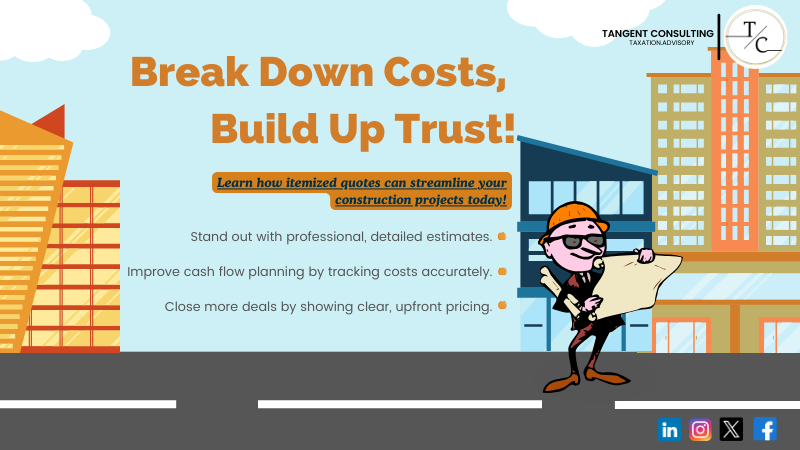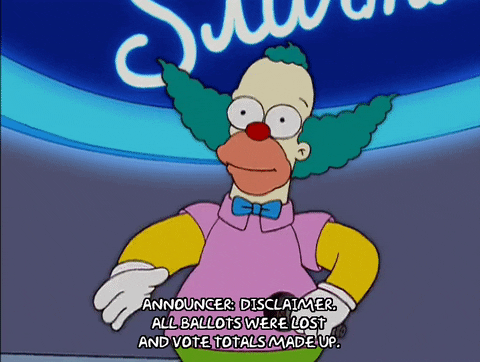How Can an Itemized Quote Help Construction Businesses?
How Can an Itemized Quote Help Construction Businesses?

Last Saturday, we ordered a burger only to find out the fries were missing. We called the restaurant; they said we had to order fries separately. We got annoyed because we didn’t get a full meal, and we are sure you would be annoyed as well.
In the same way, a construction client gets frustrated when they see unexpected costs. As a construction business, you have to justify these costs, which itself is an exasperating process. To solve this problem, we have an itemized quote. It’s like a detailed menu for your services, mentioning every cost.
So, let’s break down what itemized quotes are and how they can help construction businesses.

What is an Itemized Quote?
An itemized quote breaks down every cost, from materials and labor to subcontractor fees, into clear, separate line items instead of bundling everything into one big, mysterious lump sum.
If you were buying a custom-built home, would you rather see one giant price tag or a breakdown showing exactly how much is going toward framing, roofing, plumbing, and electrical work? That’s exactly what an itemized quote does—it gives your client full visibility into where their money is going.
For example, let’s say you’re pricing out a kitchen renovation. Instead of simply quoting $25,000 for the whole project, an itemized quote might look like this:
- Cabinet Installation: $7,500
- Countertops and Backsplash: $4,000
- Flooring: $3,500
- Plumbing & Fixtures: $2,500
- Electrical Work: $2,000
- Labor Costs: $5,500
With this level of detail, you build trust with the client and reduce confusion.

What’s Included in an Itemized Quote?
According to Emerald Insights, contract misunderstandings are one of the reasons construction disputes occur. However, these can be avoided with clear pricing. An itemized quote lays out all the details so that there’s no room for confusion. Here’s what an itemized quote typically includes:
- Installation Costs
- Product Descriptions and/or Images
- Recommended Add-Ons
- Tiered Pricing Options
- Product Warranties
- Material and Labor Costs
- Notes or Special Client Requests
- Deposit Information and Payment Terms
- Relevant Disclaimers
- Taxes, Fees, or Discounts
- Total Cost of the Job
- Quote Date and Expiration
It’s important to mention here that a quote is not an estimate. The thing is, estimates are ballpark figures, meaning they can change. A quote, however, is a fixed price for the work agreed upon. If a client accepts your itemized quote, they’re committing to that price, which protects both of you from pricing disputes later.

How Can You Create an Itemized Quote?
If you aren’t sure about creating an itemized quote, no worries! There are plenty of tools and resources at your disposal. Here’s what you can do:
1. Use an Itemized Quote Template
If you’re new to itemized quoting, templates are your best friend. They provide a structured format to list materials, labor, and costs without overcomplicating things. For example, Google Sheet has a free price quote template to help you get up and running. All you have to do is plug in your numbers and send them to your client.
2. Business Quote or Estimating Software
Want to automate the process? You can turn your itemized quotes into professional invoices with estimating software like Jobber or Housecall Pro. Here are some of the benefits of using software:
- Keep all your quotes in one place for easy access
- Ensure price accuracy and avoid miscalculations
- Send quotes on the go using a field service mobile app
Best Practices for Itemized Quote
Now that you have grasped the idea of itemized quotes let’s talk about some of the best practices that you should follow when creating them.
1. Details, Details, Details
Clients don’t just want numbers. They want to know exactly what they’re paying for. The more specific, the better. You should include:
- Specifications (brand, dimensions, model numbers)
- Estimated delivery/shipping time
- Labor breakdown (hourly rate vs. fixed pricing)
For example, instead of writing:
“Install new HVAC system – $8,500.”
Try:
“Install [Brand] 3-Ton 16 SEER HVAC System (Model #XXXX), including ductwork, labor, and removal of the old unit – $8,500.”
The extra detail reassures clients that they’re getting exactly what they need and not just a random lump sum.

2. Keep It Clear and Concise
Your clients aren’t industry pros, so avoid technical jargon, abbreviations, or acronyms that only contractors understand.
Bad Example: Includes R&R, 2×6 T&G decking, and TPO w/ flashing.
Better Example: Remove and replace old roofing, install 2×6 tongue-and-groove decking, and apply TPO roofing with flashing.
If they can’t understand your quote, they won’t trust it. So, it’s better to keep it simple.
3. Accuracy Is Everything
A wrong number today = a lost client tomorrow. You need to double-check:
- Material prices, as they fluctuate
- Labor costs
- Estimated project timeline
4. Protect Yourself with Disclaimers
Material prices, labor costs, and even shipping delays can throw off your estimates. Always include a disclaimer so you’re not locked into unrealistic expectations.
For example:
“This quote is valid for 30 days and subject to material availability. Pricing may change based on market conditions.”
This keeps you covered in case costs skyrocket or materials become scarce.

5. Get a Signature Before Starting Work
Verbal agreements are too risky. Always get a signed approval before you start, ensuring both you and the client are aligned on the following:
- Scope of work
- Pricing
- Payment terms
- Any additional work that might be needed
If extra work comes up, clearly document it in the invoice so there’s no confusion when it’s time to settle the bill.
6. Follow Up and Seal the Deal
A quote isn’t the end of the conversation—it’s just the beginning. If a client hasn’t booked yet, check in with them.
- Send a follow-up email
- Offer preventative services or maintenance add-ons (great for upselling)
- Remind them about limited-time pricing or seasonal availability
Final Thoughts
At the end of the day, a vague quote loses jobs, but an itemized quote wins clients. Take the time to outline your costs, communicate clearly, and protect your business with every quote you send.
And who knows? The next time a client gets two competing quotes, yours might be the one they trust the most.
By the way, if you don’t understand this financial mumbo-jumbo, why not let a pro handle this? Tangent Consulting has years of experience as a CFO, business coach, and tax consultant. With us, you don’t need to hire an accountant or business coach separately; you can get both in one place.
P.S. If you are reading this, it means you can have access to our free consultation for your business. Avail this for free today before we change our mind 😉
FAQs
How do I estimate and quote the price of my service to a client?
You need to break down material, labor, and overhead costs. You can use an itemized quote template or estimating software to ensure accuracy. You should always include a buffer for unexpected expenses.
How do you calculate construction estimates?
List material, labor, and equipment costs. Add overhead, profit margin, and contingencies. You can use estimating software or industry-standard rates for accuracy.
How can you politely say no when a client asks for a lower price?
Here’s what you can say, “I appreciate your budget concerns, but our pricing reflects the quality, materials, and expertise we provide. If needed, I can adjust the scope to fit your budget.”
